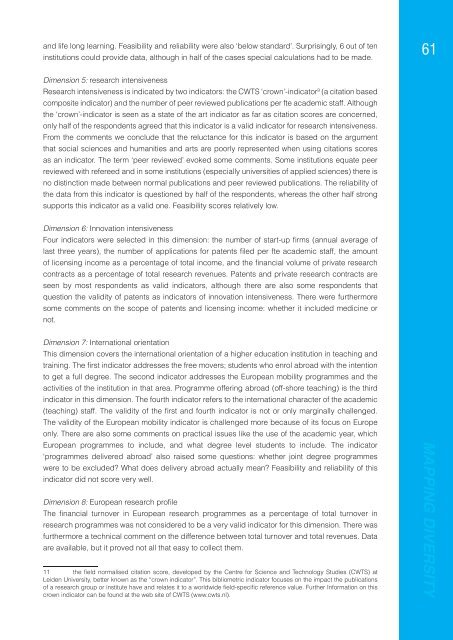Mapping Diversity: Developing a European Classification of ... - U-Map
Mapping Diversity: Developing a European Classification of ... - U-Map
Mapping Diversity: Developing a European Classification of ... - U-Map
Create successful ePaper yourself
Turn your PDF publications into a flip-book with our unique Google optimized e-Paper software.
and life long learning. Feasibility and reliability were also ‘below standard’. Surprisingly, 6 out <strong>of</strong> ten<br />
institutions could provide data, although in half <strong>of</strong> the cases special calculations had to be made.<br />
61<br />
Dimension 5: research intensiveness<br />
Research intensiveness is indicated by two indicators: the CWTS ‘crown’-indicator 9 (a citation based<br />
composite indicator) and the number <strong>of</strong> peer reviewed publications per fte academic staff. Although<br />
the ‘crown’-indicator is seen as a state <strong>of</strong> the art indicator as far as citation scores are concerned,<br />
only half <strong>of</strong> the respondents agreed that this indicator is a valid indicator for research intensiveness.<br />
From the comments we conclude that the reluctance for this indicator is based on the argument<br />
that social sciences and humanities and arts are poorly represented when using citations scores<br />
as an indicator. The term ‘peer reviewed’ evoked some comments. Some institutions equate peer<br />
reviewed with refereed and in some institutions (especially universities <strong>of</strong> applied sciences) there is<br />
no distinction made between normal publications and peer reviewed publications. The reliability <strong>of</strong><br />
the data from this indicator is questioned by half <strong>of</strong> the respondents, whereas the other half strong<br />
supports this indicator as a valid one. Feasibility scores relatively low.<br />
Dimension 6: Innovation intensiveness<br />
Four indicators were selected in this dimension: the number <strong>of</strong> start-up fi rms (annual average <strong>of</strong><br />
last three years), the number <strong>of</strong> applications for patents fi led per fte academic staff, the amount<br />
<strong>of</strong> licensing income as a percentage <strong>of</strong> total income, and the fi nancial volume <strong>of</strong> private research<br />
contracts as a percentage <strong>of</strong> total research revenues. Patents and private research contracts are<br />
seen by most respondents as valid indicators, although there are also some respondents that<br />
question the validity <strong>of</strong> patents as indicators <strong>of</strong> innovation intensiveness. There were furthermore<br />
some comments on the scope <strong>of</strong> patents and licensing income: whether it included medicine or<br />
not.<br />
Dimension 7: International orientation<br />
This dimension covers the international orientation <strong>of</strong> a higher education institution in teaching and<br />
training. The fi rst indicator addresses the free movers; students who enrol abroad with the intention<br />
to get a full degree. The second indicator addresses the <strong>European</strong> mobility programmes and the<br />
activities <strong>of</strong> the institution in that area. Programme <strong>of</strong>fering abroad (<strong>of</strong>f-shore teaching) is the third<br />
indicator in this dimension. The fourth indicator refers to the international character <strong>of</strong> the academic<br />
(teaching) staff. The validity <strong>of</strong> the fi rst and fourth indicator is not or only marginally challenged.<br />
The validity <strong>of</strong> the <strong>European</strong> mobility indicator is challenged more because <strong>of</strong> its focus on Europe<br />
only. There are also some comments on practical issues like the use <strong>of</strong> the academic year, which<br />
<strong>European</strong> programmes to include, and what degree level students to include. The indicator<br />
‘programmes delivered abroad’ also raised some questions: whether joint degree programmes<br />
were to be excluded? What does delivery abroad actually mean? Feasibility and reliability <strong>of</strong> this<br />
indicator did not score very well.<br />
Dimension 8: <strong>European</strong> research pr<strong>of</strong>i le<br />
The fi nancial turnover in <strong>European</strong> research programmes as a percentage <strong>of</strong> total turnover in<br />
research programmes was not considered to be a very valid indicator for this dimension. There was<br />
furthermore a technical comment on the difference between total turnover and total revenues. Data<br />
are available, but it proved not all that easy to collect them.<br />
11 the fi eld normalised citation score, developed by the Centre for Science and Technology Studies (CWTS) at<br />
Leiden University, better known as the “crown indicator”. This bibliometric indicator focuses on the impact the publications<br />
<strong>of</strong> a research group or institute have and relates it to a worldwide fi eld-specifi c reference value. Further Information on this<br />
crown indicator can be found at the web site <strong>of</strong> CWTS (www.cwts.nl).<br />
MAPPING DIVERSITY

















